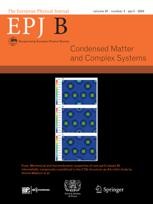Spinning towards robust microwave generation on the nano scale
New study explains why it is not possible to couple nano-scale microwave generators known as spin-torque oscillators together in series to generate a macroscopic strength signal
New York | Heidelberg, 5 August 2019
 Spin-torque oscillators (STOs) are nanoscale devices that generate microwaves using changes in magnetic field direction, but those produced by any individual device are too weak for practical applications. Physicists have attempted - and, to date, consistently failed - to produce reliable microwave fields by coupling large ensembles. Michael Zaks from Humboldt University of Berlin and Arkady Pikovsky from the University of Potsdam in Germany have now shown why connecting these devices in series cannot succeed, and, at the same time, suggested other paths to explore. Their work was recently published in EPJ B.
Spin-torque oscillators (STOs) are nanoscale devices that generate microwaves using changes in magnetic field direction, but those produced by any individual device are too weak for practical applications. Physicists have attempted - and, to date, consistently failed - to produce reliable microwave fields by coupling large ensembles. Michael Zaks from Humboldt University of Berlin and Arkady Pikovsky from the University of Potsdam in Germany have now shown why connecting these devices in series cannot succeed, and, at the same time, suggested other paths to explore. Their work was recently published in EPJ B.
The physics behind spin-torque oscillations is the same as that behind the hard disk drive of the computer on which you are very likely reading this text. It is a quantum mechanical effect known as 'giant magnetoresistance', in which changing the external magnetic field around a stack of layers of alternating ferromagnetic and non-magnetic metals gives rise to substantial changes in electrical resistance.
If the electric force produced is strong enough and the magnetic layers are free to rotate, magnetic oscillation occurs and microwaves are generated; this is the STO effect. However, only synchronised oscillations from large ensembles of oscillators can produce microwaves that are sufficiently powerful to be useful. Zaks and Pikovsky's work illustrates why it has proven so difficult to synchronise them.
To do so, the physicists simulated the motion of an ensemble of serially coupled STOs using the equations of non-linear dynamics. Their analysis revealed that the ensembles were always too unstable for the oscillations to remain coherent. In particular, they found that the random fluctuations of electric current that affect all oscillators simultaneously - so-called 'common noise' - do not stabilise the oscillations, as some had predicted. Instead, in some cases, sufficiently strong fluctuations were able to suppress the oscillations altogether.
Zaks and Pikovsky have dubbed this newly discovered phenomenon 'noise-induced oscillation death'. Armed with new theoretical knowledge on this system, they are now investigating other methods for coupling these nanoscale machines to produce robust microwaves on the macro scale.
References: M. A. Zaka and A. Pikovsky (2019), Synchrony breakdown and noise-induced oscillation death in ensembles of serially connected spin-torque oscillators, European Physical Journal B 92:160, DOI: 10.1140/epjb/e2019-100152-2
Further Information
For more information visit: www.epj.org
Services for Journalists
The full-text article is available here.
Contact
Sabine Lehr | Springer | Physics Editorial Department
tel +49-6221-487-8336 | sabine.lehr@springer.com
